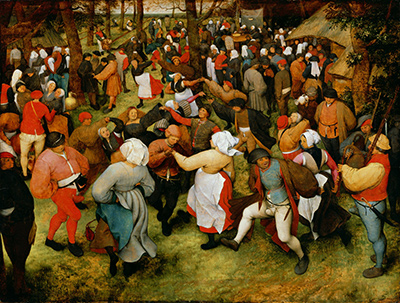Pieter Bruegel painted the iconic Wedding Dance in 1566
During his prolific career he was very much influenced by the people of the Netherlands, and the buildings that surrounded him, and this is what he conveyed beautifully on canvas.
He focussed very much upon the comfort and banality of the everyday.
The Wedding Dance is most probably known as Bruegel's most famous and widely respected painting, which at present is housed in the Detroit Institute of Art as part of their permanent collection.
The DIA's curator of European art, George Keyes, believes that Bruegel was very much immersed and influenced by the traditions that came out of the Netherlands during his lifetime.
At the time of painting the Wedding Dance, the Netherlands were governed by Spain who wanted to supress the rise of the Protestants with Catholic dominance.
In his own way, Bruegel was reminding his fellow citizens of his beloved country's values and traditions and that the country would not be so easily suppressed.
The Wedding Dance is a painting that is bursting with frivolity, fun and action.
It so vividly depicts the many drunkards who were present, as well as the gossiping women of the time.
The painting shows peasants having fun and letting go of their inhibitions, something that was frowned upon by the Catholicism of its day.
All individuals within the painting are bonny, full of life and colourful.
Bruegel has created a visually stunning and action packed painting, in which the observer cannot help but stare and see different images and intricacies every time that they look at it.
The painting breathes and echoes life.
There are many interesting concepts to this painting.
Firstly jugs feature heavily, and they are large and brightly painted. This helps to convey the message that we are indeed watching a celebration and that heavy drinking is taking place.
Secondly the bride in the painting is wearing black, and this was the popular colour back in the Renaissance.
Brides did not wear the white dresses of today, as they were associated with death and decay.
Much of Bruegel's work was centred around the observer, in that those of the upper classes were able to see what life was like for those less well off.
There is a strong voyeuristic element to this painting, as though we are privy to the secret life of peasants, a fact which is made even stronger by the couple who are kissing with their backs painted boldly towards the observer.




